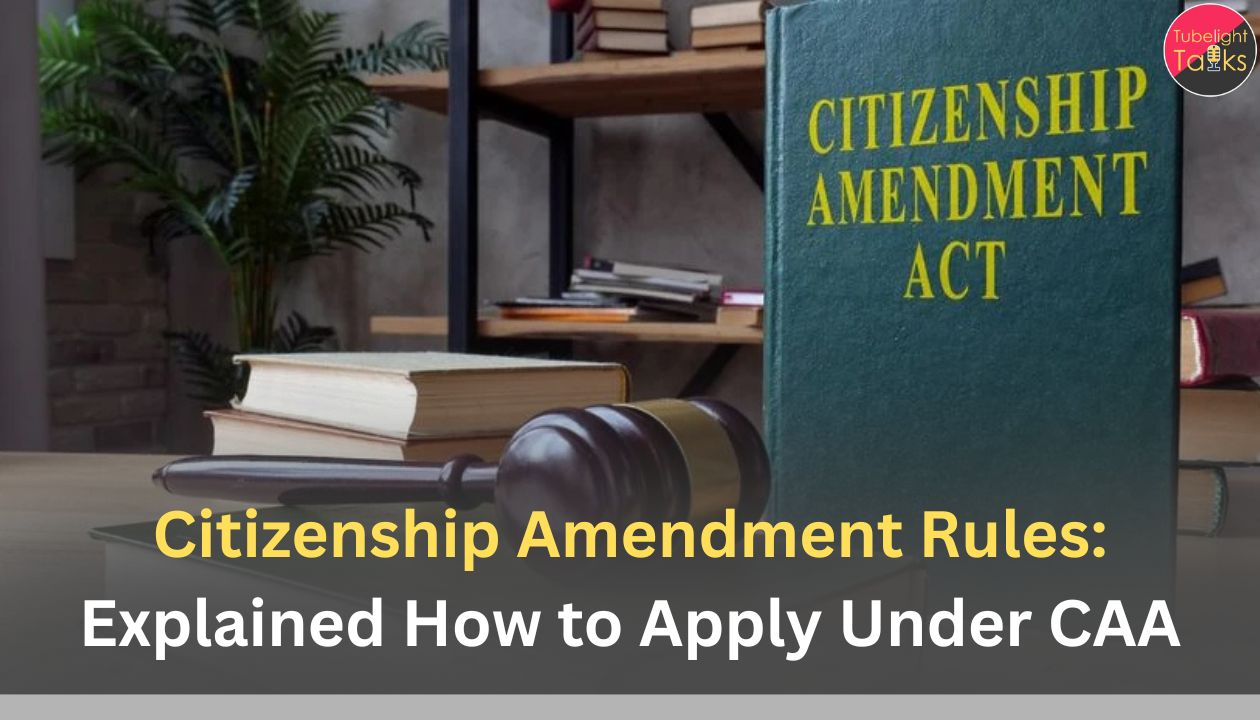India notified the Citizenship Amendment Rules, 2024 on March 11, 2024, operationalising Section 6B of the Citizenship Act, 1955 for specified minorities from Afghanistan, Bangladesh and Pakistan who entered on or before December 31, 2014. Applications are filed online and move through a District Level Committee (DLC) to an Empowered Committee (EC), with an oath of allegiance before the designated officer.
Since notification, the first citizenship certificates have been issued and state committees have begun approvals. This explainer walks through eligibility, forms, documents, workflow, and the current on-ground status—strictly from the Gazette and official portals/PIB.
Who Is Eligible Under the CAA Rules (in force since March 11, 2024)
The Rules implement Section 6B, covering persons from Afghanistan, Bangladesh or Pakistan who belong to Hindu, Sikh, Buddhist, Jain, Parsi or Christian communities and entered India on or before 31 December 2014. The application is under Section 5 (registration) or 6 (naturalisation) read with Section 6B, depending on the applicant’s category (e.g., minor child, spouse, OCI cardholder, naturalisation). The Gazette notification expressly ties the new forms and procedures to Section 6B.
The key legal switch‐on
- Rules notified: March 11, 2024 (Gazette).
- Online filing mandated; security checks & digital certificates provided for in the text.
- Oath of allegiance before the designated officer is compulsory.
Exactly How the Application Moves: DLC → EC (as per the Gazette)
The Rules insert Rule 11A and Rule 13A into the Citizenship Rules, 2009. An applicant submits electronically to the Empowered Committee through the District Level Committee. The DLC verifies documents and administers the oath of allegiance; the EC scrutinises suitability, may seek security agency reports, and on satisfaction grants citizenship with a digitally signed certificate (hard copy on request).
Who sits on these committees? (official composition)
- Empowered Committee (State/UT): Headed by the Director (Census Operations); members include an SIB officer (Dy Secy rank+), jurisdictional FRRO, State NIC officer, and the Postmaster General or nominee; invitees include a state Home dept. representative and a Divisional Railway Manager representative. Quorum: 2 (incl. chair).
- District Level Committee: Headed by the Senior Superintendent/Superintendent of Post (Designated Officer); members include the District Informatics Officer/Assistant and a Central Govt nominee; invitees include a Naib Tehsildar-level rep from the Collector’s office and the jurisdictional Station Master (availability-based). Quorum: 2 (incl. chair).
The oath, acknowledgment, and “no-show” rule
- On submission, an acknowledgment (Form IX) is auto-generated.
- The Designated Officer administers the oath of allegiance (Second Schedule to the Act), signs it, and forwards it electronically with verification to the EC.
- If an applicant fails to appear to subscribe the application and take the oath despite reasonable opportunities, the DLC forwards the case to the EC for consideration of refusal—a point reiterated on the official portal.
What Forms Do Applicants Use Under Section 6B?
The 2024 Rules add a set of Section 6B-specific forms to the Citizenship Rules, 2009:
- Form IVA – Registration of a minor child fulfilling Section 5(1)(d).
- Form VA – Registration of a person whose parents are registered citizens under Section 5(1)(a) or 6(1), fulfilling Section 5(1)(e).
- Form VIA – Registration of a person who or either parent was a citizen of independent India, fulfilling Section 5(1)(f).
- Form VIIA – Registration of a person registered as an OCI cardholder (Section 7A), fulfilling Section 5(1)(g).
- Form VIIIA – Naturalisation under Section 6B.
These forms specify residence history, family particulars, criminal case disclosures, and require the oath. For Form VIII, a tailored five-year residence check applies to the six CAA-covered communities (vs. the usual 11-year aggregate), reflected by the inserted sub-clause.
The Documents: Schedules IA, IB & IC (What You Must Upload)
Each application must include:
- One document from Schedule IA proving the applicant is/was a national of Afghanistan/Bangladesh/Pakistan (e.g., passport from those countries, or other specified national documents); and
- One document from Schedule IB proving entry/residence facts (and other identity particulars as listed); plus
- An affidavit as per Schedule IC. The Rules make clear these can include expired documents.
Step-by-Step: How to Apply Under CAA (Official Workflow)
1) Start on the official portal
Go to Indian Citizenship Online → choose the Section 6B category relevant to you (Forms IVA/VA/VIA/VIIA or VIIIA for naturalisation). The portal mirrors the Rules and lists forms and conditions.
2) Upload documents per Schedules IA/IB, fill residence details
Match your nationality evidence (Schedule IA) and residence/entry records (Schedule IB). Enter date of entry, addresses over the preceding 14 years, and other biographic details.
3) Submit, receive Form IX acknowledgment, appear for oath & verification
Once you submit, Form IX acknowledgment is generated. You must appear before the Designated Officer of the DLC to subscribe the application and take the oath; the officer then signs it and forwards your file (with verified docs) to the EC. Non-appearance after opportunities can trigger refusal consideration.
4) Security inputs & decision by the Empowered Committee
The EC can seek a security agency report online. On being satisfied that you meet Section 6B conditions and are a fit and proper person, it may grant citizenship and issue a digitally signed certificate (hard copy on option).
What Happened After Notification: Implementation Snapshot (2024–25)
- May 15, 2024: The first set of citizenship certificates after the Rules were notified was handed over in New Delhi (PIB).
- May 29, 2024: Empowered Committees in West Bengal, Haryana, Uttarakhand granted the first sets in their states (PIB).
- Year-end 2024: MHA’s Year End Review notes Rules notified and first certificates issued.
- Portal carries ongoing instructions (oath only after all documents are in order; DLC may forward no-show cases for refusal consideration).
- State example (Assam): Reported numbers have been limited—as per a September 2025 update, only 12 applications received and 3 granted (media). Treat this as a state-specific datapoint; official, consolidated all-India counts have not been detailed in one PIB note.
The Fine Print Most People Miss (Directly From the Rules)
- Renunciation declaration: Every Section 6B application must include a declaration that the foreign citizenship will stand renounced irrevocably if the application is approved.
- Digital by design: Certificates of registration (Form XA/XIA) or naturalisation (Form XIIA) are digitally signed by the EC Chair; a hard copy is available on option.
- Oath timing matters: The oath required under Sections 5(2)/6(2) is ineffective until taken before the authorised officer per Rule 38; the Rules emphasise sequencing.
Common Questions – Answered With Citations
Does the CAA apply to everyone who entered before 2015?
No. It is limited to six specified communities from three specified countries and those who entered on or before 31-12-2014; applicants must also meet the relevant registration/naturalisation criteria.
What evidence proves I am/was a national of the three countries?
Schedule IA lists options—passport etc.—and notes that documents are admissible even beyond validity. Schedule IB lists complementary records.
Who exactly verifies my file and who finally decides?
The DLC (chaired by the Postal Superintendent) verifies documents and administers the oath; the EC (chaired by the Director, Census Operations) scrutinises and grants citizenship if satisfied.
Is there an official place to apply and track?
Yes—Indian Citizenship Online (MHA). It lists the 6B forms, process notes, and conditions.
Are there official confirmations that certificates have been issued?
Yes—PIB has multiple releases (May 15 and May 29, 2024; Year End Review 2024) confirming issuance and state-level commencement.
Justice with Responsibility
Citizenship policy sits at the meeting point of law and human dignity. Sound governance demands that procedures be clear, truthful, and compassionate—verifying each claim carefully while treating applicants with respect during verification, interviews, and the oath. Enlightened Sant Rampal Ji Maharaj Discourses widely available from spiritual teachers emphasise honest conduct, non-exploitation, and fulfilling one’s duties—principles that fit this process too: officials must uphold fairness, and applicants must submit accurate records and abide by the law.
Readers interested in this values-first lens can explore teachings that frame ethical action and truthfulness as everyday duties.
Apply the Right Way—Directly, Carefully, and Only via Official Channels
Checklist before you click “Submit”
- Read the Gazette highlights (Rules notified March 11, 2024; Rules 11A/13A govern the flow).
- Pick the correct form (IVA/VA/VIA/VIIA/VIIIA) under Section 6B as shown on the Indian Citizenship Online portal.
- Attach one document each from Schedule IA and Schedule IB, plus the Schedule IC affidavit—expired docs may still be admissible as the Rules allow.
- Appear for the oath before the Designated Officer; note the no-show consequence.
- Track status; EC may seek security inputs and will issue a digital certificate (hard copy optional).
Read Also: Essential Documents That Every Indian Should Possess
FAQs: Citizenship Amendment Rules
Q1. When did CAA actually become operational?
On March 11, 2024, when the Citizenship (Amendment) Rules, 2024 were notified in the Gazette of India.
Q2. Where do I apply?
On the Indian Citizenship Online portal managed by the Ministry of Home Affairs.
Q3. Who verifies my documents and administers the oath?
The District Level Committee (Postal Superintendent as Designated Officer). Final decision is by the Empowered Committee (Director, Census Operations as Chair).
Q4. What documents do I need to prove nationality and residence?
Schedule IA lists nationality proofs (e.g., passport of Afghanistan/Bangladesh/Pakistan); Schedule IB lists additional proofs. Expired documents can be admissible.
Q5. Have certificates actually been issued?
Yes—PIB recorded the first certificates on May 15, 2024, with state-level commencements (e.g., West Bengal, Haryana, Uttarakhand) later in May; Year-end 2024 review also notes progress.
Q6. Are state numbers uniform?
No. Implementation metrics vary by state. For example, a September 2025 report from Assam cited 12 applications and 3 grants; treat such figures as state-specific and time-bound.










